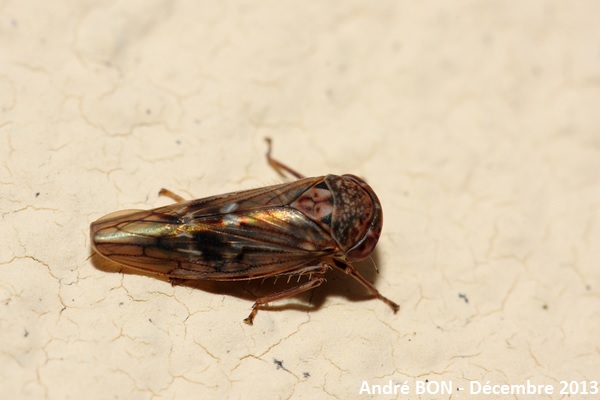
| Idiocerus lituratus (FallÚn, 1806) |

|
|
Scientific name: Idiocerus lituratus (FallÚn, 1806) Common name: French name: Order: Hemiptera Family: Cicadellidae Wingspan : 5.5 to 6.5 mm. Biotope: On Willows. Geographic area: Eurasia Observation period : July to November |
Leafhoppers of the Idiocerinae subfamily are characterized by a short wide and rounded vertex. On an upper side view, the front edge of the pronotum does not extend frontwards beyond the eyes. The two wings are one over the other at their tip. The Idiocerus genus is characterized by the lack of cross grooves on the pronotum, but the presence of shallow grooves on the vertex. The 5 species found in France, that's to say Idiocerus lituratus, Idiocerus stigmaticalis, Idiocerus similis, Idiocerus herrichii and Idiocerus vicinus are a brown general colour without green dominant colour. The front of the head is rather wide. The post clypeus is hexagonal shaped and the ocelli are close to the eyes. Idiocerus lituratus has a mainly brown body with dark veins showings some white sections. The front of the head is white with two thin brown patches close to the upper edge. The scutellum, which is wider than long, bears three black triangular spots at the base. The one in the middle is smaller. They are followed by two small dark oval spots. The cross veins at the base of the cells located at the tip of the wings are not aligned. There is a short white oblique vein on the inner edge of the wing at about one third of the length. In resting position with the two wings touching you can see like a white V shape. There is also, among others, a small Y-shaped white marking close to the inner edge at about two thirds of the wing length. Males of the Idiocerus genus have a tiny black disk at the tip of the antennae. Idiocerus stigmaticalis shows aligned cross veins at the base of the cells located at the tip of the wings. Idiocerus herrichii shows a dark V-shaped marking on the front of the head and a horseshoe marking on the scutellum. |
| [To know more about the Idiocerus lituratus] [Top] |

|
A front view would have been very useful to confirm the Idiocerus lituratus species with certainty. The species identification is then only highly probable. I have based my decision on the comparison of the wing patterns with galleries of pictures that I am considering as very reliable. The tiny black disc at the tip of the antennae indicate one male. |